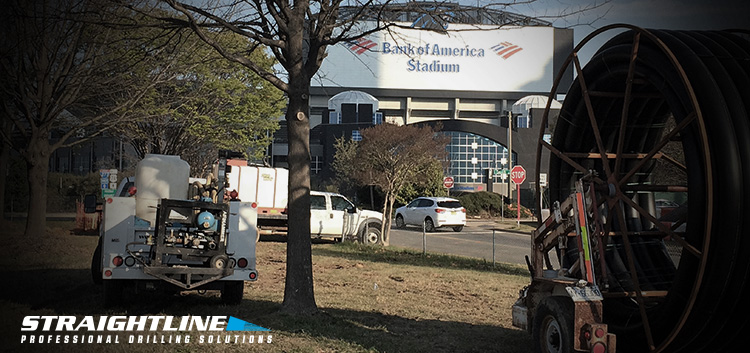
Location: Charlotte, North Carolina
Equipment: RockEye 4.0 Hammer System, Vermeer 23×30 with Atlas Copco 1000×350 compressor
The Challenge:
North Carolina-based, the CMP Technologies was tasked with a 400-foot bore to install 8-inch poly pipe. The site, located in the Charlotte, North Carolina, Center City neighborhood, required a 20-foot depth, an aggressive 12 degree left turn to follow the easement and a fairly rapid 12-15 foot ascent to reach the road cut.
Part of the state’s Charlotte Belt formation, lurking 10 feet below a mix of course gravel and loam was very old igneous—mostly limestone—rock.
Conventional Methods Attempted First
Conventional rock methods & tools were initially specified. Hitting the ground hard on the first day, the CMP crew easily punched through the first 80 feet of soft soil. Hopes of a short work day ran high.

The hard limestone conditions in the Charlotte, North Carolina Center City neighborhood stymied initial drilling attempts using conventional rock tools.

The 400-foot bore was located in the shadows of Bank of America Stadium, home of the NFL’s Carolina Panthers football team.
The enthusiasm ended quickly as the bore transitioned from soft soil into limestone. The three-tooth rock bit simply deflected off the rock. Changing the attack angle partially solved the deflection issue, but exposed a bigger problem: the rock bit simply would not cut the rock.
With production stalling, a crew member suggested contacting StraightLine HDD®. Having witnessed a RockEye® Hammer System in action with a previous employer, the crew member recalled the RockEye’s ability to steer and produce in similar conditions. A demo was scheduled.
Outcome
StraightLine field engineer, Ron Becker, arrived at the job site armed with a 4.0 RockEye. Following a quick bore review, set-up and operational briefing, the hammer hit the ground around mid-morning.
Immediately, Becker realized the soft soil provided inadequate support to the bent sub (giving way rather than allowing the bent sub to push off). “We run into this frequently,” says Becker. “We adjusted technique by increasing forward pressure, which allowed us to push and steer the assembly through soft stuff.”

Operating the RockEye, production rates clocked an impressive 15 feet/10-foot rod. Equally impressive was the flawless execution of a 12 degree turn.
Pushing through the soil layer, Becker recounted the moment the RockEye handled the transition between soft and hard conditions. “You know exactly when the hammer moves into rock—because you can hear it.”
“Once we had established a foothold in the rock—at the correct trajectory—then it was a matter of establishing a rhythm using the hammer’s carving technique” noted Becker.
As the sun set on the first day, the bore neared the halfway point. Production rates averaged 15 minutes/10-foot rod. The following morning, production continued to impress. Even on the 12 degree turn, production consistently clocked 30 minutes/10-foot rod production rates. Just ten hours after the RockEye arrived on-site, the CMP Technologies crew completed the 400-foot pilot shot.
“A lot of times, we come in after the contractor has spent days—even weeks—trying to get product in,” says Becker. “So when we get 40 plus feet production per hour, and knock a bore out in a couple of days, there’s usually a mixture of shock and amazement on the job site. That’s what we had here.”
